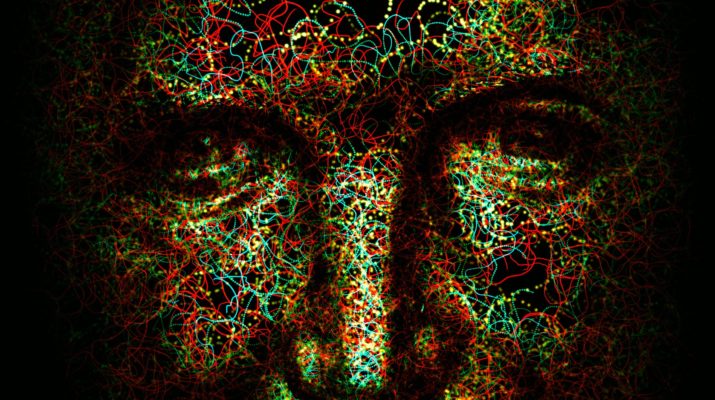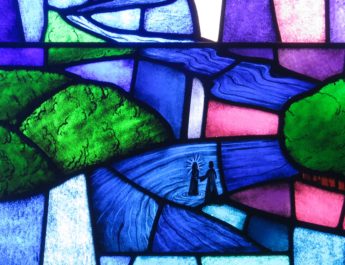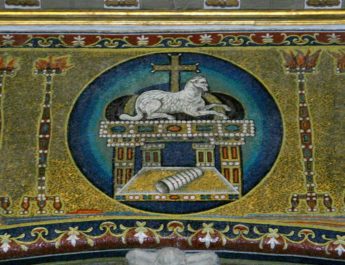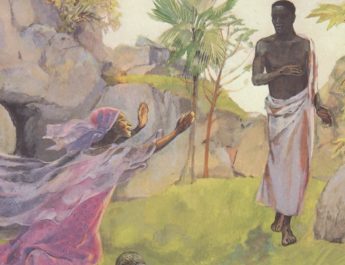Exodus 34:29-35
Transfiguration of the Lord C
BibleHub
29 AMosesB came downC from MountD Sinai.E
Notes on verse 29a
A {untranslated} = hayah. This is to be or become, to happen.
B “Moses” = Mosheh. From mashah (to pull out in a literal or figurative sense, to draw out) OR from Egyptian mes or mesu (child, son i.e. child of…). This is Moses – the one drawn out from the water, which is to say, rescued. If derived from the Egyptian, his name would share a root with Rameses and Thutmose.
C “came down” = yarad. This is to go down, descend; going down in a literal or figurative sense. It can be going to the shore or a boundary, bringing down an enemy.
D “Mount” = har. From harar (hill or mountain). This is mountain, hill, hilly region.
E “Sinai” = Sinay. Probably from the same as Sin (Sin, a city meaning “clay” or “bush);{perhaps from asam (to gather, store) OR from seneh (thorn bush) OR related to Aramaic siyn (a god called Sin) OR perhaps Hebrew siyn (related to mud or clay)}. This is Sinai – a place whose name may mean “bush of the Lord” or “muddy.” See https://www.abarim-publications.com/Meaning/Sinai.html
As he came down from the mountain with the twoF tabletsG of the covenantH in his hand,I
Notes on verse 29b
F “two” = shenayim. From sheni (double, again, another, second); from shanah (to fold, repeat, double, alter, or disguise). This is two, both, second, couple.
G “tablets” = luach. Root likely means glistening, so this would refer to a tablet as being polished in some sense, whether it’s made of stone, wood, or metal.
H “covenant” = eduth. From ed (witness, testimony, recorder); from ud (to admonish, repeat, duplicate, testify, restore, record, relieve). This is testimony, ordinance, decree, warning, or witness.
I “hand” = yad. This is hand, ability, power. Hand in a literal sense, but also what one can do or the means by which one does it.
Moses did not knowJ that the skinK of his faceL shoneM because he had been talkingN with God.
Notes on verse 29c
J “know” = yada. This is to know, acknowledge, advise, answer, be aware, be acquainted with. Properly, this is to figure something out by seeing. It includes ideas of observation, recognition, and care about something. It can be used causatively for instruction, designation, and punishment.
K “skin” = or. Perhaps from ur (to be made naked, exposed, or bare). This is skin, hide, or leather. It can also refer to a body.
L “face” = paneh. From panah (to turn, face, appear). This is face in a literal or figurative sense. It could be face, presence, anger, respect. It can also be used of God to indicate divine favor or presence.
M “shone” = qaran. 4x in OT– used 3x of Moses’s face shining upon coming from the presence of God. From qeren (horn or hill; a flask or cornet, ivory, altar corner, mountain peak, or figuratively power). This is something that gives off rays – it could be to shine or refer to horns. As horns, it could mean to gore.
N “talking” = dabar. This is generally to speak, answer, declare, or command. It might mean to arrange and so to speak in a figurative sense as arranging words.
30 When AaronO and allP the IsraelitesQ
Notes on verse 30a
O “Aaron” = Aharon. Derivation uncertain. May mean “bearer of martyrs” OR be related to Ancient Egyptian ꜥḥꜣ rw (warrior lion) OR elevated, exalted, high mountain. This is Aaron. See https://en.wiktionary.org/wiki/Aaron
P “all” = kol. From kalal (to complete). This is all or every.
Q “Israelites” = ben + Yisrael. Literally, “children of Israel.” Ben is from banah (to build or obtain children). This is son, age, child. It is son in a literal or figurative sense. Yisrael is from sarah (to persist, exert oneself, contend, persevere, wrestle, prevail) + el (God or god). This is Israel, meaning God strives or one who strives with God; new name for Jacob and for his offspring. This refers to the people and to the land.
sawR Moses,S the skin of his face was shining, and they were afraidT to comeU near him.
Notes on verse 30b
R “saw” = raah. This is to see in a literal or figurative sense so stare, advise, think, view.
S {untranslated} = hinneh. From hen (lo! Behold! If, though; an expression of surprise). This is to draw attention, show suddenness or surprise, or to emphasize the importance of the coming statement. See! Lo! Behold!
T “were afraid” = yare. This is to fear, be afraid, dreadful. It can also refer to fearful reverence – to fear in a moral sense is to say to revere, respect.
U “come” = nagash. This is to draw, bring, or come near. It is approaching for any reason – as an attack on an enemy, in order to worship, to make an argument. It can also be used as a euphemism for sex.
31 But Moses calledV to them; and Aaron and all the leadersW of the congregationX returnedY to him, and Moses spoke with them.
Notes on verse 31
V “called” = qara. This is to call or call out – to call someone by name. Also used more broadly for calling forth.
W “leaders” = nasi. From nasa (to lift in a broad sense, literally and figuratively; to carry, take, or arise; to bring forth, advance, accept). This is one lifted up or exalter. So, it could be prince, chief, ruler, captain, king, or vapor.
X “congregation” = edah. From yaad (to appoint, assemble or gather selves, agree) OR from ed (witness, testimony, recorder); from ud (to admonish, repeat, duplicate, testify, restore, record, relieve). This is a congregation, assembly, or company. It could be a family, crowd, or fixture.
Y “returned” = shub. To turn back, return, turn away – literally or figuratively. Doesn’t necessarily imply going back to where you started from. This is also the root verb for the Hebrew word for repentance “teshubah.”
32 AfterwardZ all the Israelites came near, and he gave them in commandmentAA all that the LordBB had spoken with him on Mount Sinai. 33 When Moses had finishedCC speaking with them, he putDD a veilEE on his face;
Notes on verses 32-33
Z {untranslated} = ken. Perhaps from kun (properly, in a perpendicular position; literally, to establish, fix, fasten, prepare; figuratively, it is certainty, to be firm, faithfulness, render sure or prosperous). This is to set upright. Generally used figuratively to mean thus, so, afterwards, rightly so.
AA “gave…in commandment” = tsavah. This is to charge, command, order, appoint, or enjoin. This is the root that the Hebrew word for “commandment” comes from (mitsvah).
BB “Lord” = YHVH. Related to {untranslated} in v29. From havah (to be, become) or hayah (see note A above). This is the name of the God of Israel, the self-existent and eternal one, the tetragrammaton. This pronunciation has been lost to time so “Lord” is generally used in its place.
CC “finished” = kalah. This is to end, be finished, complete, prepare, consume, spent, or completely destroyed.
DD “put” = natan. This is to give, put, set, offer. It is to give literally or figuratively.
EE “veil” = masveh. 3x in OT – all in this passage. From the same as suth (clothes, covering) or a word meaning to cover. This is a veil.
34 but whenever Moses went inFF beforeGG the Lord to speak with him, he would take the veil off,HH until he came out;II and when he came out, and told the Israelites what he had been commanded, 35 the Israelites would see the face of Moses, that the skin of his face was shining; and Moses would putJJ the veil on his face again, until he went in to speak with him.
Notes on verses 34-35
FF “went in” = bo. This is to enter, come in, advance, fulfill, bring offerings, enter to worship, attack. It can also have a sexual connotation.
GG “before” = paneh. Same as “face” in v29. See note L above.
HH “take…off” = sur. This is to turn aside in a literal or figurative sense – to depart, decline, rebel, remove, or withdraw.
II “came out” = yatsa. This is to go or come out, bring forth, appear. It is to go out in a literal or figurative sense.
JJ “put” = shub. Same as “returned” in v31. See note Y above.
Image credit: “Baubles, Bangles, and Beads!” by Shane Taremi, 2015.




